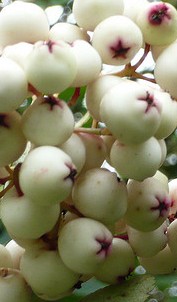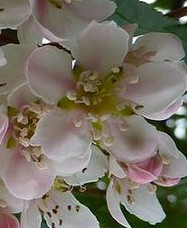 This deciduous flowering tree is a member of the rose family (Rosaceae) and is native to the Himalayas. Although it is a short lived tree it is grown as an ornamental because of its beautiful display of white berries from fall into winter. The leaves are six to nine inches long and are pinnately compound into fifteen to twenty one leaflets that are one to two inches long, serrated, dark green on the top side and lighter on the bottom side. In the fall, the leaves turn yellow to orange and red. Because the branching is open the shade caste by the tree is light. In late spring flat clusters of pale pink flowers appear that are attractive to bees and pollinating insects. Each flower has five petals, is about 1/3 inch across, and gives way to green berries that ripen to white and persist into winter. An excellent choice for a small garden.
This deciduous flowering tree is a member of the rose family (Rosaceae) and is native to the Himalayas. Although it is a short lived tree it is grown as an ornamental because of its beautiful display of white berries from fall into winter. The leaves are six to nine inches long and are pinnately compound into fifteen to twenty one leaflets that are one to two inches long, serrated, dark green on the top side and lighter on the bottom side. In the fall, the leaves turn yellow to orange and red. Because the branching is open the shade caste by the tree is light. In late spring flat clusters of pale pink flowers appear that are attractive to bees and pollinating insects. Each flower has five petals, is about 1/3 inch across, and gives way to green berries that ripen to white and persist into winter. An excellent choice for a small garden.
 Type: Deciduous flowering tree
Type: Deciduous flowering tree
Outstanding Feature: White berries; flowers
Form: Upright, open, spreading
Growth Rate: Slow
Bloom: Pale pink, five petaled, produced in flat clusters in late spring
Size: 25’ H x 23’ W
Light: Full sun but tolerates some shade.
Soil: Fertile, moderately moist, well-drained
Hardiness: Zones 5-7
Pests and Diseases: Fire blight, silver leaf, aphids, blister mites, sawflies
Propagation: Seed chilled in winter, softwood cuttings in summer, grafting in winter